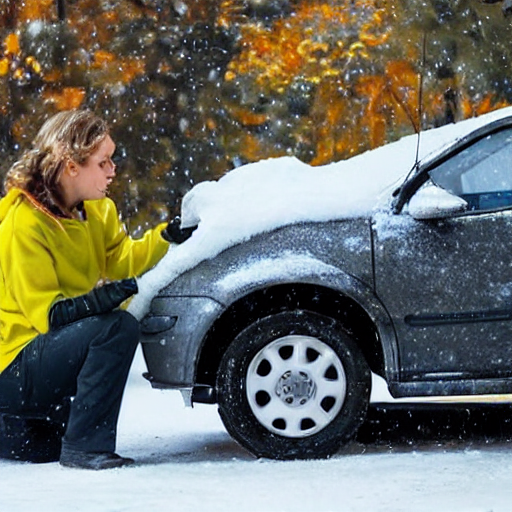Master Winter Driving: Essential Steps for Vehicle Preparation and Safety
The winter season casts a magical spell over our environment, blanketing everything in a beautiful layer of snow and creating picturesque scenes that invite cozy evenings by the fire. However, this enchanting season also brings a multitude of challenges, particularly when it comes to navigating icy roads and preparing for unexpected emergencies that can arise. As responsible drivers, it is imperative to take proactive measures to prepare ourselves for any situation that may occur during these colder months. Imagine finding yourself caught in a sudden winter storm, stranded on a desolate road with no help in sight—it’s a daunting thought. But fear not! This comprehensive guide will outline the essential steps you need to take to ensure your vehicle is fully prepared for any winter emergencies, providing you with the confidence and peace of mind needed for safe travels throughout the season.

Prioritize Your Safety: Thoroughly Remove Snow and Ice from Your Vehicle
Before setting off on any journey during the winter months, it is essential to ensure that your vehicle is entirely cleared of snow and ice. While this task may appear straightforward, many drivers unfortunately overlook this vital step. Accumulated snow on the roof, hood, or windows can significantly obstruct visibility, leading to hazardous driving conditions. In some cases, snow can slide down onto your windshield, causing a sudden loss of sight while you are driving. Furthermore, large chunks of snow or ice can become dangerous projectiles, endangering other vehicles on the road. Therefore, equip yourself with a sturdy scraper and brush, and take the time to thoroughly remove all snow and ice from your vehicle’s surfaces. This proactive measure not only enhances your safety but also contributes to the safety of fellow drivers on the road during winter weather.
Maximize Traction and Safety: Perform a Comprehensive Tire Inspection
Your tires serve as the vital contact point between your vehicle and the road, making them critical for grip and safety, particularly during winter driving conditions. Before the cold weather sets in, it is crucial to assess their condition, ensuring they are properly inflated and in excellent condition. Cold temperatures can lead to a drop in tire pressure, which significantly reduces traction on icy or snowy roads. Always consult the manufacturer’s recommended tire pressure levels, typically found in your vehicle’s manual or on a sticker located on the driver’s side door jamb.
Additionally, the tread depth of your tires plays a significant role in your vehicle's performance on snow and ice. While the legal minimum may be 2/32 of an inch, opting for tires with deeper tread can greatly improve grip and handling. Consider investing in winter or snow tires that are specifically designed for low-temperature conditions to ensure superior traction and handling ability. Remember, well-maintained tires can be the deciding factor that keeps you securely on the road, preventing dangerous situations and accidents during the winter months.
Ensure Battery Readiness: Guarantee Your Vehicle Starts Every Time
Imagine being fully prepared for your winter adventure only to find that your vehicle won’t start due to a failing battery. Avoid this frustrating scenario by proactively evaluating your battery’s condition before the temperatures drop. Many auto parts retailers offer complimentary battery inspections, and taking advantage of this service can help ensure your battery is in peak condition.
Winter weather can place additional strain on your battery; therefore, it is essential to keep the terminals clean and free from corrosion. Look for signs of aging or wear, and make sure all connections are secure. If you discover that your battery is nearing the end of its lifespan, it is wise to replace it preemptively to avoid being left stranded in the cold due to a dead battery. Keeping your battery in optimal condition is crucial for reliable winter travel and can save you from unnecessary stress.
Fluids Matter: Maintain Essential Vehicle Fluids for Smooth Operation
Maintaining the correct levels of essential fluids in your vehicle is vital for optimal performance during winter driving. Start by checking your engine coolant, often referred to as antifreeze, which is specifically designed to prevent your engine from freezing. It is crucial to ensure this fluid is at the recommended levels for efficient operation. If you are unsure about the proper levels, consult your vehicle manual or seek advice from a qualified professional.
Next, examine your windscreen washer fluid. Winter roads can quickly become slushy and dirty, obscuring your view. Refill your washer fluid, preferably with a winter blend that remains effective even in freezing temperatures. Additionally, do not overlook checking your brake fluid and engine oil; ensuring they are at the appropriate levels is essential since cold temperatures can adversely affect their performance. Properly maintained fluids are crucial for your vehicle's smooth operation and overall safety, particularly during the challenging winter months.
Be Prepared for Emergencies: Assemble Your Comprehensive Winter Emergency Kit
In the event of a winter crisis, having a well-stocked emergency kit in your vehicle is akin to having a reliable companion at your side. Be sure your kit includes critical items such as a dependable flashlight, extra batteries, jumper cables, a reflective vest, a warm blanket, gloves, and a hat. Additionally, don’t forget to include a first aid kit, non-perishable snacks, and water as essential supplies to have on hand. You might also consider adding a portable phone charger, a compact shovel, and materials like sand or kitty litter to improve traction if you become stuck.
Always remember that being prepared for the unexpected is essential when navigating winter conditions. Regularly check and replenish your emergency kit to ensure you are equipped to handle any situation that may arise. Being proactive can make a significant difference in your safety and well-being during winter travel, allowing you to handle emergencies with confidence.
Enhance Your Safety: Ensure Your Vehicle Lights are Functioning Properly
With shorter days and longer nights during the winter months, verifying that your vehicle’s lights are functioning correctly is critical for your safety. Take the time to inspect all external lights, including turn signals, brake lights, headlights, and taillights. Replace any burnt-out or dim bulbs to ensure optimal visibility for both yourself and other drivers on the road. Proper lighting not only improves your visibility while driving but also ensures that you are visible to others, significantly reducing the risk of accidents during crucial moments.
Wiper Blades: Guarantee Unobstructed Visibility During Harsh Winter Weather
Winter weather often brings snow, freezing rain, and slushy road conditions that can severely impair visibility while driving. To combat these challenges, it is vital to have wiper blades that are in excellent working condition. If your current wipers are leaving streaks or failing to effectively clear moisture, it is time to replace them. Consider investing in winter-specific wiper blades designed to handle harsh conditions, as they can greatly enhance your visibility during snowstorms and freezing rain, ensuring you can navigate safely and confidently.
Stay Informed: Monitor Weather and Road Conditions for Safe Travel
To effectively navigate the challenges of winter driving, remaining informed about weather conditions and potential road closures is crucial. Before embarking on any journey, check the weather forecast and stay aware of possible hazards along your route. Utilizing weather apps, tuning into local news stations, or listening to radio announcements can provide you with real-time updates on changing conditions and help you make informed decisions.
Additionally, it’s wise to inform someone of your travel plans, including your intended route and estimated arrival time. This way, should any emergencies arise, someone will have an idea of where to look for you. By adhering to these simple yet effective tips, you can be well-prepared for any winter emergency, ensuring a safe journey. Remember, it’s always better to be over-prepared than caught off guard. Embrace the beauty of the winter season while ensuring your vehicle is equipped to handle whatever challenges lie ahead. Safe travels!
The post Preparing Your Vehicle: Stay Ahead of Winter Challenges appeared first on Survival Bite.
The Article Preparing Your Vehicle for Winter Challenges Ahead Was Found On https://limitsofstrategy.com


I really appreciate how you highlighted the importance of winter driving preparedness. I remember the first winter I drove in a snowy area; I was completely unprepared and ended up getting stuck for hours! That experience taught me the value of keeping essentials in the car, like a blanket and a basic emergency kit. It’s also fascinating how vehicle technology has evolved—many newer cars come with features like adaptive all-wheel drive that can make navigating icy roads a lot easier. Have any of you tried using these tech features? They can really change your approach to winter driving. I’d love to hear what specific steps or tools everyone else finds indispensable during winter!
I can relate to your experience. Winter can catch anyone off guard, especially if you’re new to driving in snowy conditions. The lesson in preparedness sticks with you, doesn’t it? Keeping essentials like blankets and an emergency kit in the car isn’t just a good idea; it’s a small action that can make a huge difference in an unfortunate situation.
“Thanks for sharing your story! If you’re interested in enhancing your winter driving experience further, check out this guide on essential tools and tech features that can keep you safe and prepared on the road.”
https://mannland5.com/octopus
I can totally relate to your experience of getting caught out in the snow without being ready. It’s one of those learning moments that really sticks with you, right? Keeping essentials like a blanket and an emergency kit in the car can make all the difference. There’s just something comforting about knowing you’re prepared for unexpected challenges.
Your insights on winter driving preparation truly resonate with me, especially as someone who has had my fair share of icy road experiences. I remember one particularly frigid evening, I encountered a sudden snowstorm while driving home from work. It felt as if the world outside transformed within minutes; what had started as a manageable drive quickly turned into a nerve-wracking journey through reduced visibility and slippery conditions. Thankfully, I had taken some of the steps you mentioned in your guide, like equipping my vehicle with winter tires and keeping an emergency kit in my trunk.
Your experience really highlights how quickly conditions can change and how preparedness makes all the difference. That sudden transformation from a manageable drive to a nerve-wracking journey is something many of us can relate to. It’s a reminder that what begins as routine can shift dramatically in the blink of an eye, especially in winter.